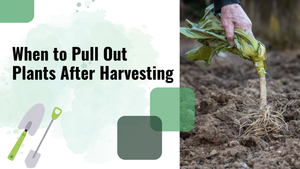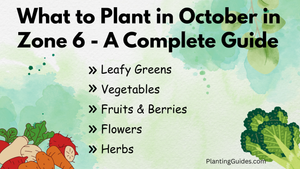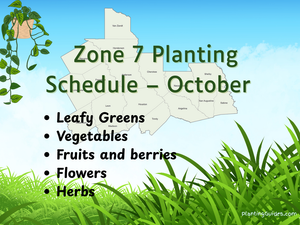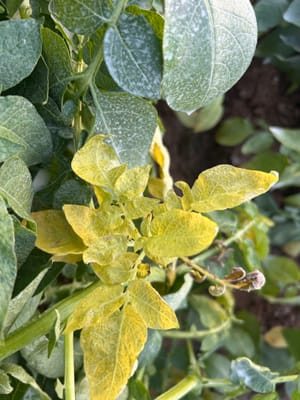
You know what? November in Zone 9 is cool and comfortable — not too hot, not too cold, perfect for both plants and gardeners. The soil is warm enough till now, frost comes late, and the weather is just right for planting. It's a great time to grow cool-weather crops that love cool temperatures and gentle sunshine.
During this time of year, daytime temperatures are usually between 65–75°F, and nights can drop to around 40–55°F, It actually depands on your exact location. The first frost normally comes in late November or around mid-December, usually near December 15.
This month, you can grow fresh greens, tasty root vegetables, herbs, and even some beautiful flowers that keep blooming through the winter.
Leafy Greens to Plant in November in Zone 9
The cool weather of November helps leafy greens grow fast, crisp, and full of flavor — not bitter or wilted from the hot sun.
If you have ever dreamed of growing your own fresh salad greens with little effort, November is one of the best months to plant easy growers like lettuce, spinach, and arugula.
| Leafy Green | Planting Method | Transplanting Time | First Harvest | Variety Recommendations |
|---|---|---|---|---|
| Arugula | Direct sow ¼" deep, thin to 4" | N/A | 30-40 days | Rocket, Wasabi, Astro |
| Bok Choy | Direct sow or transplant 6" apart | 25-30 days | 45-60 days | Mei Qing Choi, Purple Lady |
| Collards | Transplant 18" apart | 30-35 days | 60-70 days | Champion, Morris Heading, Georgia Southern |
| Endive | Transplant 8-10" apart | 25-30 days | 50-60 days | Curl-it, Witloof |
| Kale | Direct sow or transplant 12-18" apart | 20-30 days | 50-65 days | Lacinato, Redbor, Winterbor |
| Lettuce (head/leaf) | Direct sow ¼" deep, thin to 6" | N/A | 45-60 days | Buttercrunch, Romaine Parris Island, Great Lakes |
| Mustard Greens | Direct sow ¼" deep, thin to 4" | N/A | 30-40 days | Osaka Purple, Mizuna, Green Wave |
| Radicchio | Direct sow or transplant 8" apart | 25-30 days | 60-70 days | Pallo Rossa, Variegato di Castelfranco |
| Spinach | Direct sow ½" deep, 2-4" apart | N/A | 40-50 days | Tyee, Space Hybrid, Bloomsdale Long Standing |
| Swiss Chard | Direct sow or transplant 6-12" apart | 25-35 days | 50-60 days | Fordhook Giant, Bright Lights, Rainbow |
| Watercress | Direct sow in moist soil | N/A | 50-60 days | Upland Cress, Belle Isle |
I highly recommend sowing seeds early in the month while soil temperatures are still above 45°F for faster germination.
I always water my plants in the morning so the leaves dry before night, which helps stop mildew and other plant diseases.
Vegetables for Zone 9 in November
This is actually the season for root veggies, brassicas, and winter favorites. Zone 9’s soil stays workable year-round, so get those seeds in, and trust me, you'll get wonderful results.
If frost is expected and the temperature drops below 35°F, cover your plants with row covers or old towels overnight and remove them the next morning once the temperature rises above freezing.
| Vegetable | Planting Method | Transplanting Time (Days After Sowing) | First Harvest | Variety Recommendations |
|---|---|---|---|---|
| Beets | Direct sow ½" deep, thin to 3" | N/A | 50-60 days | Chioggia, Bull's Blood, Detroit Dark Red |
| Broccoli | Transplant 18-24" apart | 30-35 days | 60-75 days | Belstar, Di Cicco, Calabrese |
| Brussels Sprouts | Transplant 18-24" apart | 30-40 days | 90-110 days | Catskill, Long Island |
| Cabbage | Transplant 12-18" apart | 25-30 days | 60-80 days | Red Express, Stonehead, Early Jersey Wakefield |
| Carrots | Direct sow ¼" deep, thin to 2" | N/A | 70-80 days | Nantes, Cosmic Purple, Danvers 126 |
| Cauliflower | Transplant 18-24" apart | 25-35 days | 60-75 days | Snow Crown, Purple Cape |
| Celery | Transplant 6-8" apart | 30-40 days | 100-120 days | Ventura, Tall Utah, Tango |
| Garlic | Plant cloves 2" deep, 4-6" apart | N/A | Late spring/summer | California Softneck, Rocambole, Music |
| Kohlrabi | Transplant 4-6" apart | 20-25 days | 50-60 days | Kolibri, Purple Vienna |
| Onions (sets/bunching) | Plant sets 1" deep, 4" apart | N/A | 60-90 days | Red Creole, Texas Sweet, White Lisbon |
| Parsnips | Direct sow ½" deep, thin to 3" | N/A | 100-120 days | Hollow Crown, Guernsey |
| Peas | Direct sow 1" deep, 2" apart on trellis | N/A | 60-70 days | Sugar Ann, Little Marvel, Oregon Sugar Pod |
| Potatoes (seed) | Plant 4" deep, 12" apart | N/A | 90-120 days | Yukon Gold, Red Norland |
| Radishes | Direct sow ½" deep, thin to 1" | N/A | 25-30 days | Watermelon, French Icicle, Cherry Belle |
| Rutabagas | Direct sow ½" deep, thin to 4" | N/A | 80-100 days | American Purple Top |
| Sweet Potatoes (slips) | Transplant slips 12" apart | 25-30 days | 90-120 days | Beauregard, Jewel, Covington |
| Turnips | Direct sow ½" deep, thin to 2" | N/A | 40-50 days | Shogoin, Tokyo Market, Hakurei |
I always loosen the soil about 10–12 inches deep before planting root crops. From my experience, if the soil is too hard, the root crops like carrots and radishes grow short and twisted.
I heard from many experienced gardeners that a light frost actually improves the flavor of most root vegetables.
Flowers to plant in Zone 9
You can plant cool-season annuals now in November; they'll grow roots in the mild 50°F soil and bloom beautifully all winter and continue into spring.
Just make sure your flower plants get enough sunlight and have well-drained soil (mix in compost and a bit of sand).
| Flower | Planting Method | Soil Type | First Bloom | Type |
|---|---|---|---|---|
| Alyssum | Sow ¼" deep | Well-drained, fertile soil | Winter-spring | Annual |
| Calendula | Sow ¼" deep | Loamy, well-drained soil | Spring-summer | Annual |
| Chrysanthemums | Transplant seedlings 18" apart | Rich, well-drained soil | Fall-winter | Perennial |
| Pansies | Transplant seedlings 6-8" apart | Moist, rich soil | Winter-spring | Annual |
| Violas | Transplant seedlings 6-8" apart | Moist, fertile soil | Winter-spring | Annual |
| Snapdragons | Transplant seedlings 9-12" apart | Moist, well-drained soil | Winter-spring | Annual |
| Dusty Miller | Transplant seedlings 10-12" apart | Sandy, well-drained soil | Winter-summer | Perennial |
| Stock | Transplant seedlings 8-10" apart | Rich, well-drained soil | Winter-spring | Annual |
| Dianthus | Transplant seedlings 6-10" apart | Loamy, well-drained soil | Spring-fall | Perennial |
| Petunias | Transplant seedlings 10" apart | Light, fertile, well-drained soil | Spring-frost | Annual |
| Sweet Peas | Sow 1" deep | Rich, loamy soil | Spring | Annual |
Try to plant early in the month so the roots get a chance to settle in before the cold weather hits.
If your plants wilt a little after a cold night, don't worry — a little sunshine will bring them back.
Now, you might be wondering, Petunias in November? Yup. Many experienced Zone 9 gardeners say it's totally fine. Just cover them if temps drop below 38°F.
Fruits and Berries
| Fruit/Berry | Planting Method | Soil Type | First Harvest | Variety Recommendations |
|---|---|---|---|---|
| Blackberries | Bare-root canes 3-4' apart, trellis | Well-drained loamy soil | Next summer | Triple Crown, Prime-Ark Freedom, Navaho |
| Blueberries | Bare-root 4-5' apart, acidic soil | Acidic sandy loam (pH 4.5–5.5) | Next summer | Sunshine Blue, Misty, Jewel |
| Citrus (dwarfs: lemon, orange) | Bare-root or container 8-10' apart | Slightly acidic, well-drained sandy soil | 1-2 years | Meyer Lemon, Satsuma Orange, Calamondin |
| Figs | Bare-root 10' apart | Loamy, well-drained soil | Next summer | Celeste, Brown Turkey, Kadota |
| Grapes | Bare-root vines 6-8' apart, trellis | Well-drained sandy or loamy soil | 1-2 years | Muscadine Carlos, Concord, Thompson Seedless |
| Peaches | Bare-root 15' apart | Loamy soil with good drainage | Next summer | Florida Prince, TropicBeauty, Desert Gold |
| Plums | Bare-root 12-15' apart | Sandy loam, well-drained | Next summer | Methley, Santa Rosa, Bruce |
| Pomegranates | Bare-root 10-12' apart | Loamy or sandy soil, slightly alkaline | Next fall | Wonderful, Eversweet, Angel Red |
| Raspberries | Bare-root canes 2-3' apart | Moist, well-drained loamy soil | Next summer | Heritage, Caroline, Autumn Bliss |
| Strawberries | Bare-root crowns 12" apart | Rich, well-drained loamy soil | Next spring | Chandler, Sequoia, Albion, Camarosa |
Plant these crops on a cool, cloudy day if you can. Trust me, it helps the plants settle in without getting shocked by the sun.
For your berries, mix some compost with a little pine needles or peat moss; berries love slightly acidic soil.
Herbs to Plant in November in Zone 9
If you live in Zone 9, you can grow herbs almost all year. Just protect them from frost and don't overwater. The cool November weather helps herbs stay fresh, flavorful, and healthy.
I think it's best to grow herbs in containers because you can easily keep them safe from frost, just bring the pots inside when it gets too cold.
| Herb | Planting Method | First Harvest | Flavor | Variety Recommendations |
|---|---|---|---|---|
| Chives | Sow seeds or divide old plants about 8" apart | 60 days | Mild onion flavor | Fine Leaf, Siberian Garlic |
| Cilantro | Sow seeds ¼" deep and thin seedlings to 6" | 45-50 days | Fresh, citrusy flavor | Calypso, Marino, Leisure |
| Dill | Sow seeds ¼" deep directly in the garden | 40-60 days | Tangy, slightly sweet flavor | Fernleaf, Bouquet, Mammoth |
| Oregano | Start indoors, then move plants 12" apart | Next spring | Strong, earthy flavor | Greek, Hot & Spicy, Italian |
| Parsley | Sow seeds or set small plants 6" apart | 70 days | Mild, slightly peppery flavor | Forest Green, Triple Curl, Giant of Italy |
| Rosemary | Plant young transplants about 24" apart | Next spring | Pine-like, bold flavor | Arp, Tuscan Blue, Salem |
| Sage | Plant young plants or cuttings 18" apart | Next spring | Earthy, slightly peppery flavor | Tricolor, Pineapple, Common |
| Thyme | Plant small plants about 12" apart | Next spring | Lemony, savory flavor | Lemon, English, French |
| Basil | Sow seeds ¼" deep indoors or outdoors after frost | 60-70 days | Sweet, slightly peppery flavor | Genovese, Thai, Lemon, Sweet Basil |
I actually grow strong herbs like thyme, rosemary, and sage in the garden soil, and plant soft herbs like basil and cilantro in pots so I can bring them inside when it gets cold.
Water your herbs only when the soil feels dry. They don't like staying in wet soil, especially when it's cool outside.







